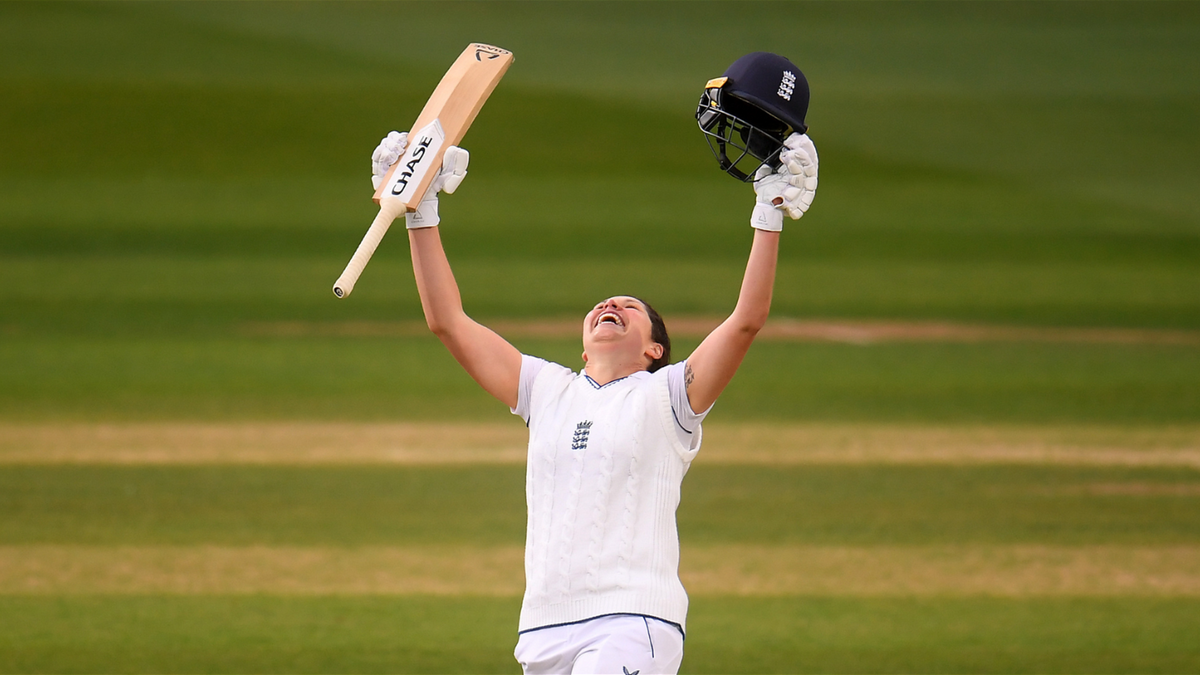
Yas Rana was at Taunton to witness a special performance on debut from Alice Davidson-Richards, and an enthralling Test that could have been so much more.
When Alice Davidson-Richards brought up her hundred at Taunton, there was a stat doing the rounds that sounded too good to be true. In the 145-year history of the Test game, only Davidson-Richards and W. G. Grace have taken a wicket and scored a hundred on England Test debut.
That’s not where the similarities end. Both made their Test debuts when they were well into their careers; Grace at 32, Davidson-Richards at 28. Grace’s delayed debut was because, well, there literally wasn’t Test cricket played in England before his bow in 1880. In Davidson-Richards’ case, this is just England’s fourth Test since she made her international debut in 2018.
And there would have been points in those four years where you’d be forgiven for thinking that her Test debut may never come. Before this Test, the six white-ball games Davidson-Richards played in the space of 14 days in the spring of 2018 were her only appearances for her country. Since then, she has endured periods when she wasn’t centrally contracted in the pre-regional contract era and in her mid-twenties was finding work as a personal trainer.
Had the rain not intervened, Davidson-Richards’ second-day hundred may well have been the defining contribution in England’s first Test win on home soil since 2005. When she came to the crease, England were 121-5 and still trailing South Africa by 163. By the time of her dismissal on the last ball of the day, Davidson-Richards and Nat Sciver had taken England into the lead.
All three hundreds in this Test were ones to marvel at and savour. The other two were scored by two of the pre-eminent all-rounders in the women’s game right now; it is to Davidson-Richards’s credit that despite her relative lack of international experience, she did not look out of place grouped with that pair. The way she was flexible in her own method in response to the bowling she faced and the match situation belied her international inexperience. She was equally comfortable digging in to score nine off the first 45 deliveries she faced as she was accelerating to score 50 off the last 73 she encountered.
It is a success story that someone at the age of 28 who did not possess a full-time contract back in 2020 can thrive now. At 28, she’s England’s oldest Test debutant in twenty years. That should be the age that players reach their prime; it is a good thing that the financial realities of a professional career in the game now mean that players who make good on their promise later than others can still have successful international careers.
Her Kent coach, David Hathrill had long suspected that Test cricket was the format that would suit her most. “Working with her over a period of time I’ve seen the quality that she has,” Hathrill told Wisden.com. “I think she’s definitely somebody that’s suited to the longer formats.”
England’s quest for a first win on home soil since 2005 did not end in victory but there were still plenty of moments that bode well for the future. The four debutants were all genuinely impressive. Aside from Davidson-Richards, Lauren Bell got the new ball to talk, Emma Lamb was assured at the top of the order and Issy Wong was the protagonist in the most thrilling passage of play in the match – her spell under lights on the third evening.
But there were also familiar frustrations. Regular bursts of rainfall took the best part of a day out of the match and the lack of a fifth day robbed the Test of the finale it deserved. The schedule was also not fitting for the quality of cricket on display, either. None of the four days were scheduled on a weekend day – when was the last time this happened for an England men’s Test? Half of the Test was played out in front of meagre crowds. Yes, the rain didn’t help but the scheduling was surely the more dominant factor.
The location plays a part, too. Not since 2001 have England played a women’s Test at a men’s Test venue. Holding Tests in the middle of the week at smaller grounds in smaller cities is not giving women’s Test cricket its best chance to succeed. If anything, it’s setting it up to fail. The women’s Hundred last summer showed that there is a large potential audience of people who want to watch elite women’s cricket. The current scheduling does not do enough to feed into that.
It is not all doom and gloom, though. The fixture list is slowly starting to reflect the growing demand for the women’s game. The women’s international summer comes to an end with an ODI at Lord’s, which, preposterously, is England’s first international at the ground since they lifted the World Cup trophy there in 2017. And even at Taunton, a fine venue that should be applauded for the pitch it produced and whose ground-staff worked tirelessly to ensure there was as much cricket played as possible, there were heartwarming stories that demonstrated the game’s growth and future potential.
For instance, there was one spectator, a solo traveller from Bracknell, who was at the ground for all four days having only discovered his love for the game having first listened to Kate Cross and Alex Hartley’s No Balls podcast in 2020. Within two years, that initial curiosity had transformed into devoted and dedicated support.
That is not an isolated example of the sport’s expanding fandom. The support is out there, the game just needs to do more to engage with it. As Davidson-Richards showed, it’s never too late to invest in the right places.







